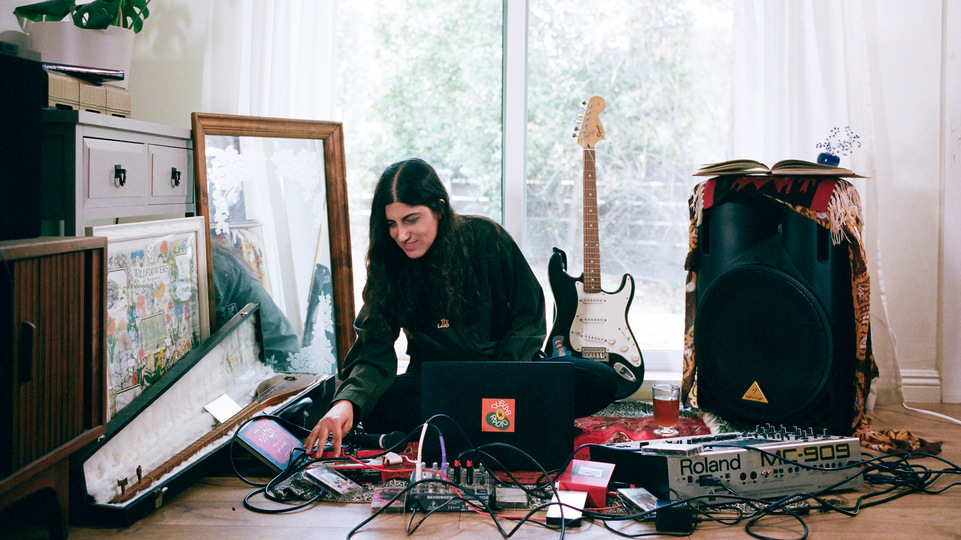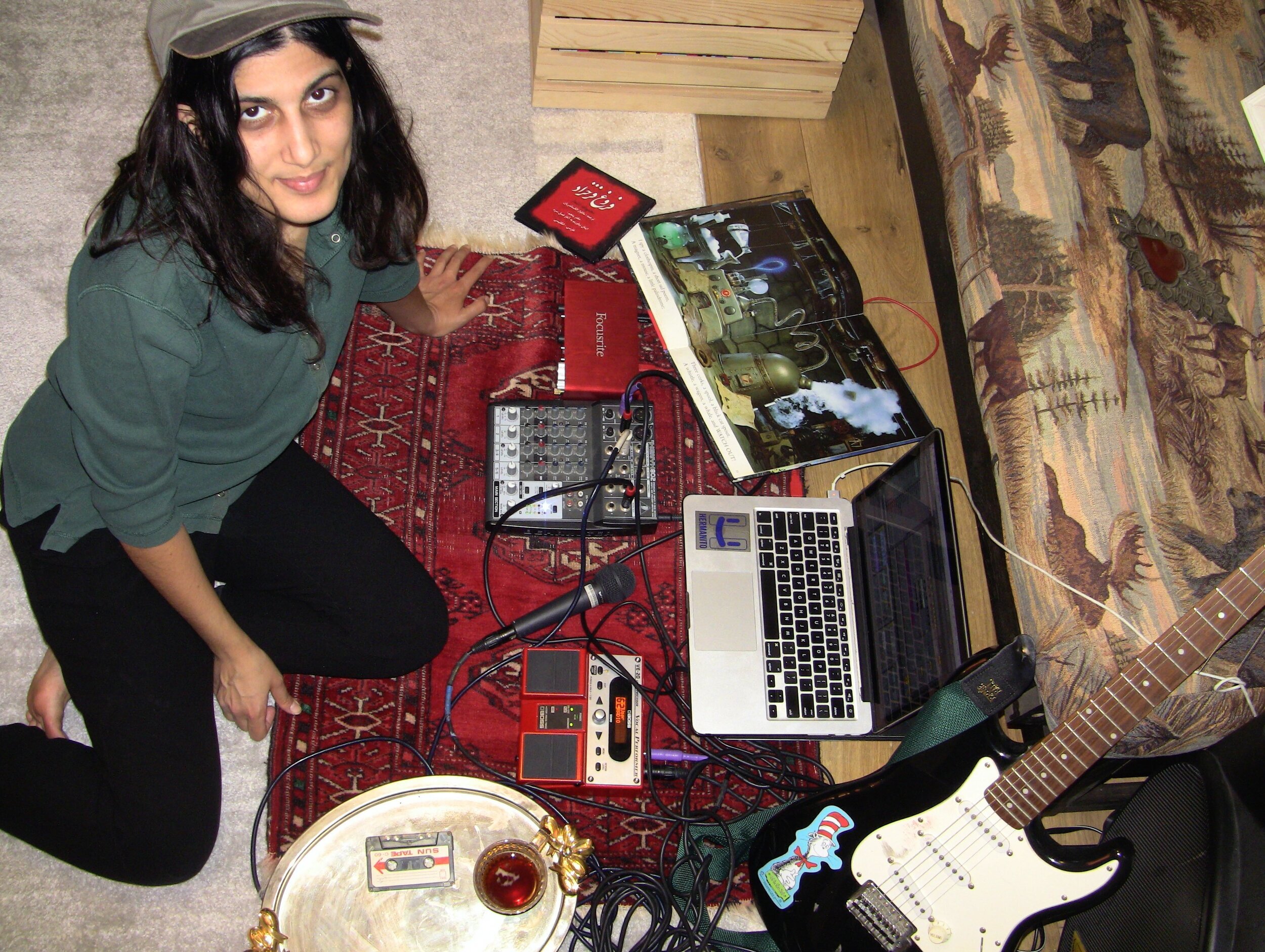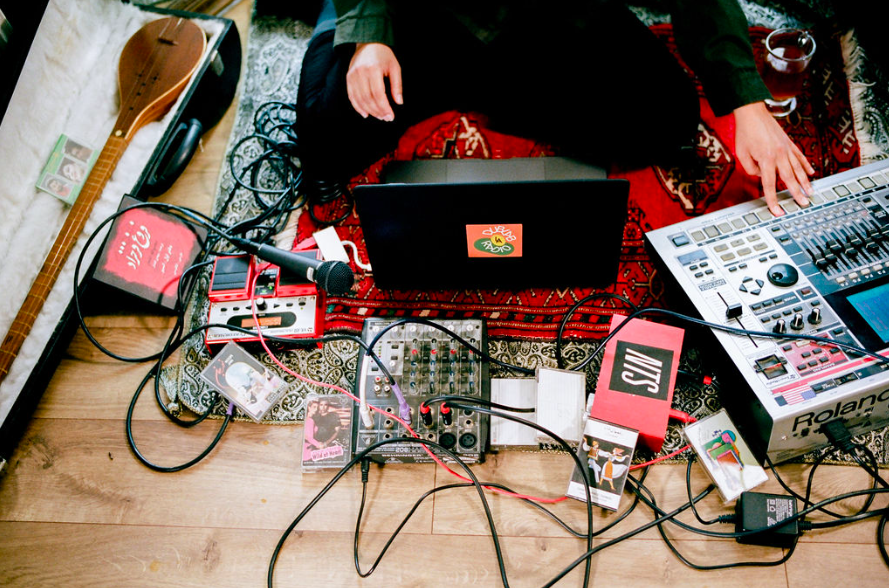Narratives of recorded histories. Interview with Maral Mahmoudi
“The identity of Persian music hovers between Orient and Occident, filled with Western pop culture and at the same time evoking the intimacy of the musical tradition and folklore of multi-ethnic Iranian society. It is therefore a constantly shimmering kaleidoscope of poetry, philosophy, and the intoxicating, untamed sounds of Persia.”1
Known for her experimental music in which modernity dialogues with the traditions of Middle Eastern soundscapes, Maral Mahmoudi is a Los Angeles-based artist of Iranian descent.

Maral Mahmoudi, photo from private collection
Her debut, Mahur Club (2019), set the tone for her artistic course, creating a contemporary, genre-free sound that mixes traditional Iranian melodies with modern rhythms and sound effects. The follow-up album, Push (2020), continued this sonic collage, incorporating even more unconventional sound structures and collaborations with artists such as Lee „Scratch” Perry and Penny Rimbaud. Since then, she has released many other works and collaborative projects, including wondering dub, lavender’s love, entropy & kindness with Lara Sarkissian, and a lot of film music.
She is affiliated with Ninja Tune, Big Dada Recordings, Dublab, Leaving Records, and Pop Can Records. As a member of the SISTER collective, she promotes the work of women in electronic music and reflects on cultural identity and the future of music.
NP: Your work integrates club music, dub effects, and sampling while drawing from Iranian folk, pop, and classical traditions. How do you conceptualise this synthesis, and what does it reveal about the relationship between contemporary and traditional soundscapes?
MM: I’ve always approached my music-making as a listener first and foremost. I spent years digging and digesting music and the history behind it before I ever got the chance to make it. At first, it was frustrating for me not to have had the opportunity to make music at a young age, but now I appreciate that I had that time to absorb and learn about the philosophy behind my favourite music; to wonder whether it is the spirituality and improvisation behind Iranian Classical Music, the politics of Crass, or the boundary-pushing of dub. These elements then naturally blended into the unique sound I discovered once I had the chance to play around in Ableton; and again, it also took years of fine-tuning before it turned into the sound I’m now known for.
NP: You have described Voices from the Land of Iran as an anthropological endeavour. It brings together archived field recordings of spiritual chants, mourning rituals, and celebratory songs from different Iranian regions, alongside more contemporary elements like Hayedeh’s music. Could you elaborate on your methodological approach to this project and its role in preserving or recontextualising these sonic traditions?
MM: I had discovered this amazing compilation of field recordings of Iranian folk music from different regions of the country, and was so inspired by its rawness captured there. I was interested in hearing these ancient sounds in a new context, in what they would sound like in a punk band or at a rave. Places that this music has never gone before.
So much of Iranian music had been passed down orally for centuries and I wanted to uphold that tradition as well as the practice of improvising within the repertoire. That led me to incorporate the DJ beat element into the mix. It was the mix that unlocked the idea of jamming with these tracks/samples and creating my version of a “band” with them. I still sample from this compilation, sometimes sampling the same track over and over again throughout the years.

Maral Mahmoudi, photo from private collection
NP: Mahur Club presents a striking fusion of reggaetón rhythms with Farsi vocals. What led you to this particular combination, and how do you see it in a broader context of musical hybridity and diasporic sound cultures?
MM: I had been trying to figure out ways of playing Iranian music at the club since I’ve always been compelled to share the sounds of Iran with my friends and show it in a wider context. Most Iranian music has a melancholy to it that makes it hard to play in a party setting so by combining it with club & reggaeton beats I was able to imbue my DJ sets with the spirituality of the music while people could still dance. I had just moved to Los Angeles from Virginia and was exposed to so much amazing music by the Mexican community in LA. From reggaeton to cumbia, I noticed that the rhythm of reggaeton complimented the Iranian music and allowed the music to step outside of its normal constraints and fell in love with the combination. I wanted to capture that feeling of sitting in my apartment with the windows open listening to Iranian classical and pop music while a car drove by blasting reggaeton.
NP: Do you consider deep bass frequencies as a medium for reinterpreting or transmitting aspects of Iranian musical traditions?
MM: I don’t associate deep bass with Iranian music. One of the reasons I have for sampling it is to incorporate a more organic sound to my music. To me, deep bass is the epitome of electronic music, dub, and seeing music live. I want the bass in my music to have this specific feel, as if you were trying to find the location of an underground rave. You hear the bass from afar, and as you get closer, the bass gets louder and louder until you find your destination. I was also heavily influenced by how Animal Collective used bass in their live performances. It wasn’t just an instrument but more of a texture and statement that helped you along the experience of seeing them live.
NP: Could you share some insights into your artistic trajectory? How has your understanding of music evolved over time, and how do you position your practice within broader cultural and historical frameworks?
MM: I’ve always approached my music-making with a beginner’s mind. That has changed a bit as I’ve started daydreaming of expanding my sound beyond my own experiments. I’ve been lucky to meet so many amazing artists and musicians during my artistic journey. Now I’m in a mindset where I would like to see them interpreting my samples and approach to sound. I’ve been incorporating more instruments like the guitar, setar, and synths, as well as collaborating with other producers and vocalists. I am excited to see where the sound goes next.

Photo from private collection
NP: In your DJ Mag interview, you stated: “Music, poetry, and nature—those are the tenets of being Iranian.” How do you see your work in relation to cultural memory, political expression, and diasporic identity?
MM: My work is organically based in all three of those tenets. So much of what influenced me was growing up going to Iran and being exposed to the beautiful culture, people and sounds. Walking down the street, listening to Western music on my iPod while hearing the distorted azan playing from the mosque. Drinking tea with my family and listening to their stories about the history of Iran, the poetry and art that imbues everything and their pride in it. I owe so much to my family, to their perseverance and positive attitude despite all the hardships. It showed me that through art, you can pass down traditions that make life special. Even if there is deep sadness in it.
NP: Could you tell me more about your new project, Girls Playing Soccer?
MM: Girls Playing Soccer is a short film by the amazing Ari Mamnoon. It includes a collaborative score by me and one of my favourite artists, Rahill. It was exciting to work with fellow Iranian women artists on this piece, especially two people whose art I love. The three of us bonded over feeling like outsiders our whole lives, not really fitting the frame of what it means to be an Iranian woman. Finding each other was such a blessing. This project is hopefully only the start to more collaborations with both Ari and Rahill.

Frame from Girls Playing Soccer, director: Ariana Mamnoon, Camera: Jack Dione, music made in collaboration by Rahill Jamalifard and Maral Mahmoudi featuring the words of Iranian poet Forough Farrokzhad
NP: For those interested in the ethnographic study of Iranian music, which artists or archival resources would you recommend exploring?
MM: I would recommend looking on YouTube; there is so much amazing footage and live performances of the great Iranian classical players, as well as folk music. I think searching for and reading about Iranian classical music will help you find what aspects of it you are drawn to, which instruments you would like to explore, and the importance of each one to the culture. That way, you can go into it with a wider knowledge than just listening to a specific artist or compilation. I will shout out some of my personal favourites, like Mohammad Reza Lotfi, Ebadi, Hayedeh, Elaheh, and Shajarian. And if you want to listen, I made a mix of my favourite Persian classical music last year:
Idin Samimi Mofakham and Martyna Kosecka, Introduction, audiopaper Iran, https://audiopapers.glissando.pl/introduction/. ↩

